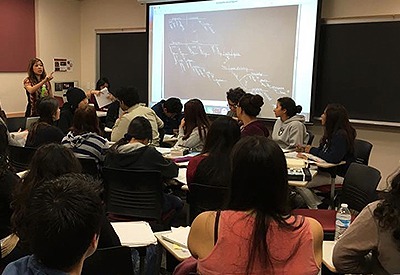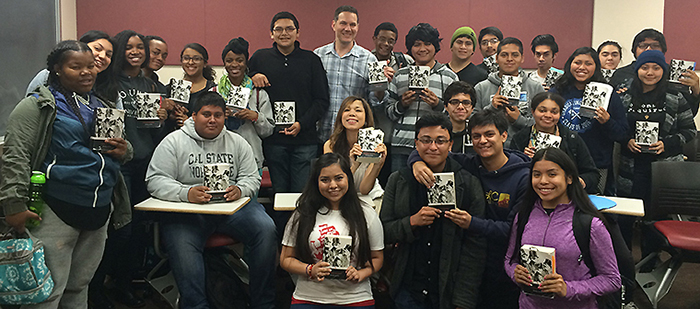"The British Empire . . . whoah!" enthused Amber Johnston (17) after an historical timeline lesson on Charles Dickens's 1847-8 novel Dombey and Son had encompassed two chalkboards and two hours of conversation in her South Los Angeles classroom. Johnston was one of many student participants in a three-day long "Dickens Intensive" held last month on the USC campus for the USC Neighborhood Academic Initiative (NAI)—a program that prepares first-generation college-bound students in the neighboring South Los Angeles communities for college.
Led by Jon Michael Varese, Director of Digital Initiatives for the Dickens Project, and Jacqueline Barrios, the AP English teacher for NAI, the three-day Intensive, part of the Dickens Project's ongoing partnership with NAI, focused on Dombey and Son with an eye toward this year's Dickens Universe. As a result of the Dickens Project-NAI Partnership, established in 2015, NAI has committed to incorporating Dickens into its senior English curriculum each year, taking its cue from the book announcement at the annual Dickens Universe. "We read the Dickens Project's selected novel in our community," Barrios said, "but also with the larger community, which gathers every summer at UC Santa Cruz."
By the end of the first day's seminar, the Dombey and Son timeline, which Varese built with students on a chalkboard, collected data that tracked the novel's connections to such far flung topics as the defeat of the Spanish armada, the rise of English cities, the sugar import industry, the definition of a bureaucracy, growing literacy, World War II and, of course, the present moment. Amber Johnston, a student of Guatemalan and Belizean descent, was fascinated to learn that Belize had been a part of the British colonial juggernaut—the "empire upon which the sun never set."

Jacqueline Barrios walks students through a multi-level diagram of one of Dickens's most complex sentences.
During the three days' worth of special classes, seminars, and writing workshops, students connected closely read passages that galvanized, among other things, their own thoughts about psychological, social, and physical mobility. Students especially connected to Dickens's own childhood deprivation, and how he thus in many ways, "fought for the little guy," as Varese explained. "I really connected with Dickens having to leave school to go work at a factory at the age of 12," said Angela Juarez (17). "It's reassuring to know that your struggles don't define you, and that your legacy won't necessarily be limited to just your era."
The Intensive is the latest innovation in the Dickens Project-NAI partnership, which continues to supply uniform copies of the Dickens novel under study for 70+ NAI seniors each year. "For many of these students," Barrios said, "the books that come through the Dickens Project grant are the first novels they've ever owned."
Additionally, the partnership provides for a number of student and teacher scholarships to attend the Dickens Universe at UC Santa Cruz. Students must submit an essay to qualify for the scholarship, and must be in good standing within the NAI program. "I really enjoyed the 'what's the argument' portion of our writing workshop," said Georgia Delgado (17). "We discussed thesis statements and placing them on sticky notes right in front of us, and I definitely see how and why this strategy works when you're trying to develop a good essay."
Dickens also might have usefully forestalled the usual student bemoaning of multiple drafts. After Varese presented a digitized page from the manuscript of Dickens's Our Mutual Friend, Mauricio Garcia (17) became forever impressed by Dickens's infamous cramped script and inked-over lines on un-ruled paper. "Writing is a continual process that involves many revisions," Garcia said, "even at the most experienced level."
Winners for the 2016 Dickens Project-NAI scholarships are expected to be announced later this month.

